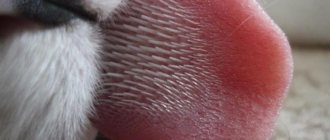An animal, like a person, experiences the world around it with the help of five basic senses. The ears, which carry out the function of hearing, are the second most important organ of information perception after vision. For cats (especially those who lead an outdoor lifestyle), the importance of this organ cannot be overestimated. Thanks to him, the animal knows how to navigate, recognizes impending danger and gets food for itself.
Hearing loss for a wild cat is tragic. This makes her completely defenseless. But this is not the case for a pet. For her, deafness is not a tragedy. It only changes the animal’s usual way of life, forcing it to adapt to new conditions. If we take into account the good adaptive qualities of a cat, then with some attention and help from a caring owner, the quality of life of a deaf animal can be quite high. Our article will tell you about the types of congenital and acquired deafness, how hearing loss is determined and what to do if your cat is deaf.
Classification of deafness
Depending on the origin, deafness in cats can be congenital or acquired.
Congenital deafness can have two causes:
- pathologies of intrauterine development of the fetus, leading to disruption of conductivity or perception of sounds in the structures of the hearing organ;
- aggravated heredity - the presence of the white coat color gene W.
Acquired hearing loss that develops into deafness can be acute or chronic.
- acute deafness occurs suddenly, symptoms increase rapidly over a short period of time;
- Chronic deafness develops gradually over many months or even years. A distinction is made between stable and progressive deafness.
Types of deafness by level of damage
- Conductive hearing loss is acquired. A pathological obstruction occurs in the path of sound transmission or amplification in the ear. This disorder can occur at the level of the outer ear (this includes malformations, cerumen plugs, otitis or neoplasms, ear parasites) or the middle ear (injuries and malformations of the eardrum, otitis media, otosclerosis). If the disease that caused the pathology is curable, then this type of deafness is reversible.
- Sensorineural deafness is often congenital. Most often, this is a pathology of the inner ear, which is a damage to the sensors - the hair cells of the inner ear. With their help, mechanical vibrations are converted into electrical impulses. This also includes pathologies of the auditory nerve. The perception of sound with this type of deafness is distorted or disappears completely. When the disease is acquired, its cause is often infectious diseases (meningitis, encephalitis), autoimmune diseases (Wegener's granulomatosis), as well as microcirculatory disorders in the inner ear, Mernier's disease.
- Central deafness occurs due to severe pathologies of the central nervous system and brain in cats. Its percentage in the total number of cases of deafness is small.
- Age-related deafness is a consequence of degenerative processes in the body of an animal on the verge of old age. The disease begins with the appearance of senile hearing loss in older individuals. It is slowly progressive and irreversible, and finally gives way to complete deafness.
Symptoms of deafness in cats
Congenital deafness does not always appear from the first days of a kitten’s life. Sometimes hearing disappears only after 2-3 weeks. In adult cats, hearing function begins to decline with age. But it’s not for nothing that these animals are famous for their endurance, because they have a very developed compensatory function. When hearing begins to deteriorate, other senses become more acute; they help animals navigate space and catch every movement in it.
But deafness sooner or later becomes clear to the owners themselves, when the animal begins to react differently to familiar situations. For example, if previously it was enough to open the refrigerator door or rustle a bag of food for the fluffy to rush immediately in the hope of getting something tasty, then with a hearing impairment the animal ignores these once attractive sounds. Pussies stop responding to the owner’s call, to which they previously joyfully rushed. In addition, they are not afraid of loud bangs and do not react to noise.
Deafness is not a serious disease unless it is caused by inflammation in the ear. As soon as you suspect your animal has symptoms of hearing loss, you should contact your veterinarian. Or you will be prescribed treatment that will restore your ability to hear. Or they will confirm the presence of deafness and give recommendations on how to care for such an animal.
Features of congenital deafness
Many owners know the fact that white cats with blue eyes often have a congenital defect such as deafness. Such cats have a special dominant W gene in their genotype. It is the presence of this gene that makes the likelihood that a white cat will be deaf very high. In some cases it reaches 80%. In turn, congenital deafness in individuals of a different color is an extremely rare phenomenon.
The dominant W gene is pleiotropic, that is, it is responsible for the presence of several traits at once. In addition to white coat color and deafness, it also makes blue eye color dominant. The probability of deafness among white individuals is distributed as follows:
- animals with blue eyes are deaf in 80% of cases;
- animals with heterochromic eyes (one eye is blue and the other is a different color) are deaf in 40% of cases;
- animals with eyes of any color (except blue) are deaf in 20% of cases.
It has been noted that deafness in white cats, caused by the presence of this gene, can be either unilateral or bilateral (long-haired beauties most often suffer from it).
How does deafness develop in white individuals?
It is known that absolutely all kittens are born deaf, with closed ear canals. By the age of 5-7 days they gradually open. At the age of two weeks, the kitten is able to determine the direction of a sound, and by a month, it can already distinguish sounds. In a white kitten, due to genetic disorders, by the time the ears open (at a week of age), the organ of Corti, the receptor part of the auditory analyzer, located in the auditory labyrinth and responsible for analyzing sound signals, atrophies.
Features of natural and artificial selection of white cats
In the wild, white cats survive much less often than others, since they turn out to be much less adapted to the unfavorable factors of the surrounding reality. The reasons for this are as follows:
- high probability of deafness;
- photophobia, which is promoted by a light shade of the eyes;
- poor vision in low light conditions.
In conditions of artificial breeding, white cats are very popular because they have an attractive appearance. They are actively bred, despite the high likelihood of physical defects.
How to determine the degree of deafness?
People who decide to have a white kitten need to know all the nuances associated with the peculiarities of its development. Not all kittens are equally deaf. Before buying a new family member, you should find out what type of hearing he or she has already at the stage of selecting an applicant. After all, it may well be that not everyone is able to provide a normal life for a deaf child and teach him to understand a person.
Everyone knows that kittens meow. It turns out that if a cat is deaf, then he screams in a higher voice than his brothers and sisters. To determine hearing, a simple technique is used: they create noise stimuli to which a deaf animal will not react in any way. For this purpose you can:
- clap your hands loudly;
- turn on the vacuum cleaner;
- slam the door;
- rustle with something that makes a loud sound, for example, chocolate foil or a regular bag.
Of course, if you approach a deaf cat from behind and touch its body, it will flinch in surprise. An ordinary cat reacts completely differently to the arrival of a person. Thanks to his excellent hearing, he will turn around before you approach, or will point his ears in the direction of your steps.
But still, a veterinarian can give a full guarantee that cats are deaf.
Causes of acquired deafness
The most common causes of acquired deafness are:
- Traumatic damage to the integrity of the eardrum. These are caused by falls from heights, blows, inept ear cleaning or acoustic trauma.
- Complications of infectious diseases. With advanced otitis media, the internal structures of the ear are involved in the inflammatory process, and the pet may become deaf. If the disease progresses and is complicated by purulent inflammation affecting the meninges, there will be a real threat to the animal’s life.
- Tumors of the ear structures or parts of the brain responsible for hearing function are the most difficult in terms of treatment and prognosis. Irreversible changes may occur.
- Ear parasites cause temporary hearing loss. Severe itching leads to severe scratching and injury to the outer ear structures. Competent and timely treatment can completely correct the situation.
- Ear plugs are a consequence of poor hygiene. Your cat's ears should be cleaned regularly to remove any wax that has accumulated there. Increased sulfur production is usually evidence of a malfunction of the excretory system.
- Age-related deafness in older cats is an inevitable symptom that is a sign of degenerative changes in the auditory nerve or structures of the inner ear.
Symptoms of the disease
Cats adapt well to their condition at the expense of their other senses. There is a certain belief that their sensitivity is so heightened that they hear by perceiving sound vibrations in the bones of the skeleton and vibrissae. They sense movement behind them by vibrations in the air.
And yet, the onset of deafness can be determined. It is usually accompanied by the following symptoms:
- meowing too loudly;
- lack of reaction to opening the refrigerator door or to the rustling of a bag of food;
- loss of orientation, frequent looking around;
- shaking the head, rubbing the ears with a paw;
- in case of an infectious disease or sulfur plugs, an unpleasant odor may be felt;
- The old cat doesn't respond to his name.
To confirm your suspicions, you need to make some sound at some distance from the animal. A well-hearing cat will react by turning its ears. A louder sound will cause fear and a reaction from the whole body. If these signs are not present, it means that the fears have been confirmed, and the cat cannot hear at all.
How can I tell if my cat is deaf?
As we mentioned at the beginning of the article, it is difficult to determine deafness in cats, especially if it is only one ear or partial deafness. Since pets cannot communicate that they cannot hear, the best test for confirming the presence or absence of deafness is to observe the cat's reaction to sounds (the animal must be consciously aware of the sound).
For example, try different types of noises and from different objects (starting with soft noises, gradually increasing the intensity) and observe how the cat reacts (or not) to them. Often cats will make an involuntary movement of their ears (known as the "Pryor reflex") in response to sound.
If you suspect your cat may have a hearing problem, consult with your veterinarian to determine the type of deafness and how to intervene.
Diagnosis of the disease
If symptoms of deafness appear, you should show your pet to a veterinarian; only he will be able to professionally determine the presence of deafness, its level, and the cause. The following methods exist for this:
- Examination of the auricle and inner ear (using a special device - an otoscope). This allows you to determine the presence of injuries, infections, and ear parasites.
- If an infection is detected, an additional cytological examination is performed.
- The presence of genetically determined deafness can be verified using a special instrumental study that allows one to determine the auditory potential of the brain stem when the hearing organ is irritated by sound vibrations.
- If the presence of neoplasms is suspected, magnetic resonance or computed tomography is used.
Diagnosis of deafness in cats
The ears have a rather complex structure; only the coordinated work of the eardrum, middle and inner ear helps the animal to hear well. If there is a problem at any of these stages, then hearing is lost. This phenomenon is often observed in older cats due to age-related changes.
Deaf cats are also called “eternal sleepers” because even the loudest sounds that cause a reaction in healthy individuals cannot wake them up. Typically, normal cats react to the appearance of a person in advance, especially if he is not sneaking on tiptoe, but simply walking at a normal pace.
You can check how close you need to get for the animal to hear you. It is necessary to make several such measurements to find out the exact distance from which the pussy begins to hear, since each time it can be different depending on the phase of sleep. The average value is taken as the truth.
Another sure way to determine deafness is to call an animal to you from another room. If the pussy does not respond to the voice, then there is a possibility of decreased hearing function. True, some cats may deliberately ignore you in order to once again demonstrate who is boss.
Only a veterinarian can diagnose “complete deafness” with certain accuracy. A specially developed BAER (Brainstem Auditory) test will help you do this. The procedure is painless for the animal; the main thing is to hold the cat and allow the doctor to attach a special clip with electrodes to the ear. Each ear is studied separately; for this purpose, the second one is plugged with an earphone or a foam insert. Next, an acoustic noise is made and the brain's reaction is checked. A well-hearing cat will have impulses in its brain in response to sound, which will be reflected on the monitor screen. With deafness, the brain does not respond to noise, and therefore impulses do not appear.
Deafness is not a reason to give up an animal. Such pets get along well with their owners and even interact with them, but the reaction is no longer to the voice, but to gestures or facial expressions. The owners of such pussies learn to establish eye contact with them, so man and animal get along well, understanding each other without words.
Treatment of the disease
Treatment methods for deafness vary depending on the causes that cause it:
- Congenital deafness in white cats cannot be treated. From birth, such a cat needs special conditions of care and special methods of communication with the owner.
- Treatment of ear infections or ear parasites is carried out using antimicrobial and antiparasitic agents, respectively, in combination with pain medications.
- Benign and malignant neoplasms can only be cured surgically, after which the animal is subjected to chemotherapy to eliminate the consequences of the disease.
- Ear plugs are removed mechanically, very carefully penetrating the ear cavity with a swab and a cotton swab.
If your pet is deaf
Why cats love boxes and bags: why do they climb into them?
What to do if your pet is still deaf? It is worth remembering that a cat, even if it is deprived of this important organ for it, is capable of feeling quite harmonious. Cats feel healthy and happy if their owner provides them with proper care.
You must always remember that because of your illness, your pet may end up in an unpleasant or dangerous situation. It is necessary to ensure that the cat does not encounter situations where she needs to hear sound signals, otherwise she may be injured. The pet may not hear the sound of an approaching car or the barking of a stray dog; such situations simply should not be allowed!
Despite this, we must understand that the cat does not feel its injury and cannot understand that it is special. The owner must remember this, devote time to his white friend, love him and pamper him in different ways, remembering that the pet is special, which means the attitude towards him must be appropriate!
Any cat, regardless of its gender, age, color, eye color, coat structure, breed, or hereditary diseases, can become an excellent friend for many years! Any cat, like any living creature, needs attention, care, and acceptance for who it is!
Features of caring for a deaf cat
We can say that congenital deafness is not a pathology, but a feature of the white color. Since the animal is born deaf, it does not adapt, but lives, from birth actively including the other senses (vision, touch and smell). Therefore, caring for such kittens is practically no different from caring for their healthy counterparts.
White cats are extremely popular among cat lovers, so they are bred despite the risks. But this process should be controlled by an experienced breeder. Errors in the selection of pairs threaten that deafness, as a genetic trait, may manifest itself in the offspring. In addition, there is a high probability that sickly and non-viable offspring will be obtained.
There are several specific features of keeping deaf pets:
- One of the main conditions is that such cats should not be allowed outside alone, as they are more exposed to various dangers than others.
- You should not approach the cat from behind, so as not to scare it. As a last resort, when entering, you can slam the door louder or stomp, creating vibrations that are clearly felt by the animal.
- They can read lips, so it is necessary to address her in such a way that she sees the owner’s face.
- You need to be extremely careful when being in the same room with a deaf pet so as not to step on it.
Deafness is not a reason to throw your furry pet out onto the street or euthanize it. With careful attention, love and care, this deficiency will not be noticeable to either the owner or his pet.
Gene mutation test
Why are some cats “talkative” with their owners, while others are silent?
To test for deafness or the deafness gene, a so-called BAER test is performed. In the vast majority of cases it gives accurate and truthful results. Deafness most often affects only one organ of hearing, so it is very difficult to notice it at home. But if the cat is at risk, then the best option would be to check the furry one so that his descendants do not inherit this gene.











